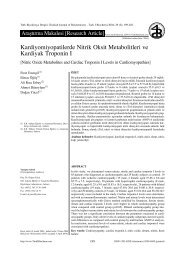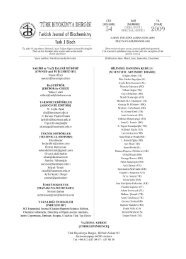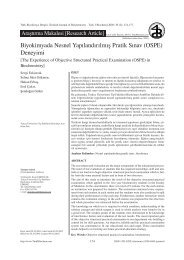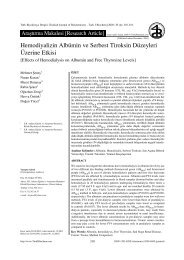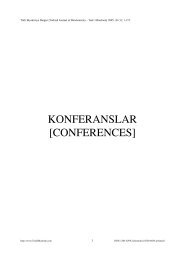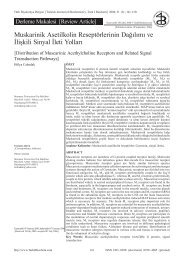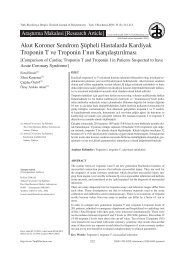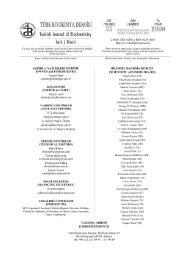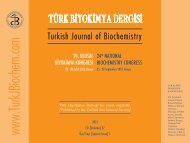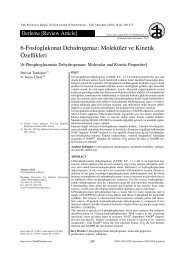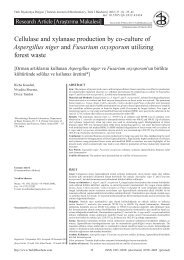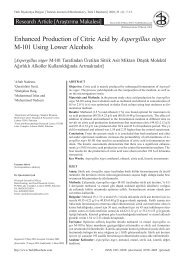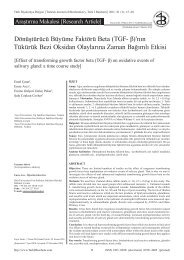23. Ulusal Biyokimya Kongresi Ãzel Sayısı - Türk Biyokimya Dergisi
23. Ulusal Biyokimya Kongresi Ãzel Sayısı - Türk Biyokimya Dergisi
23. Ulusal Biyokimya Kongresi Ãzel Sayısı - Türk Biyokimya Dergisi
Create successful ePaper yourself
Turn your PDF publications into a flip-book with our unique Google optimized e-Paper software.
XXIII. ULUSAL B‹YOK‹MYA KONGRES‹<br />
29 Kasım - 2 Aralık 2011<br />
Hilton Hotel - Adana<br />
<strong>23.</strong> <strong>Ulusal</strong> <strong>Biyokimya</strong> <strong>Kongresi</strong>, Adana [23 rd National Biochemistry Congress, Adana / TURKEY]<br />
İÇİNDEKİLER<br />
DAVETLİ KONUŞMACI ÖZETLERİ<br />
TARIMSAL BİYOTEKNOLOJİ ÜRÜNLERİNİN RİSK ANALİZİ<br />
Ali Esat KARAKAYA<br />
Gazi üniversitesi, Eczacılık Fakültesi, Toksikoloji Anabilim Dalı, Ankara.<br />
Tarımsal biyoteknoloji ürünü olan ilk tohumun 1996 yılında ABD’nde ekilmesinden bu<br />
yana dünyada biyoteknoloji ürünü bitkilerin ekim alanları devamlı olarak artmaktadır.<br />
1996 yılında 1.7 milyon hektar olan üretim alanları 2010 yılında 148 milyon hektara<br />
yükselmiştir. Bu 87 kat artışa denk düşmektedir. Bugün biyoteknoloji ürünü<br />
bitkiler 15.4 milyon çiftçi tarafından 29 ülkede ekilmektedir. Diğer yandan tarımsal<br />
biyoteknoloji ürünleri toplumda tartışma konusudur. Başlıca sağlık endişesi yeni<br />
üründe istenmeyen protein ve protein olmayan toksik bileşiklerin oluşması ihtimalidir.<br />
Bu çeşit istenmeyen yapısal değişiklikler konvansiyonel ıslah çalışmalarında da<br />
mümkünken yalnız biyoteknoloji ürünleri kapsamlı regülasyonlara ve pazar öncesi<br />
güvenlik testlerine tabidir. Biyoteknoloji ürününün, eskiden beri kullanıldığı için<br />
güvenli sayılan karşılığı olan geleneksel ürünle, kıyaslamasına dayanan eşdeğerlik<br />
konsepti güvenlik testleri için başlangıç noktasıdır. Güvenlik değerlendirilmesinde, bu<br />
kıyaslamadan sonraki adım risk analizidir. Risk analizi birbiri ile ilişkili üç bölümden<br />
oluşur; risk değerlendirme, risk yönetimi ve risk iletişimi. Bir tarımsal biyoteknoloji<br />
ürünü eğer güvenlik değerlendirilmesinden geçebilirse, bilimsel olarak tüketim için<br />
güvenli sayılmaktadır. Bu gerçeğe karşın toplumun genetiği değiştirilmiş gıdalar<br />
hakkındaki endişeleri giderek artmaktadır. Bu sunumda toplumun konudaki hatalı<br />
algısının nedenleri üzerinde de durulacaktır.<br />
Anahtar Kelimeler: Tarımsal biyoteknoloji ürünleri, Güvenlik değerlendirmesi, Risk<br />
analizi<br />
RISK ANAYSIS OF AGRICULTURAL BIOTECHNOLOGY PRODUCTS<br />
Ali Esat KARAKAYA<br />
Department of Toxicology, Faculty of Pharmacy, Gazi University, Ankara.<br />
The first genetically modified seeds were planted in the United States for commercial<br />
use in 1996. Following this start, the cultivation area of the biotech plants has<br />
continuously expanded worldwide from 1.7 million hectares in 1996 to 148 million<br />
hectares in 2010 (87-fold increase). Today biotech plants are cultivated by 15.4 million<br />
farmers in 29 countries. On the other hand agricultural biotechnology products and<br />
food derived from them are subject to public discussion in terms of safety. The main<br />
health concern is the possibility of occurrence of undesired protein and non-protein<br />
toxic substances in the new product. Although such unintentional compositional<br />
changes in plants are likely with all biotechnological and conventional breeding,<br />
only biotechnological plants are under the strict regulations and safety assessment<br />
procedures before marketing. The concept of substantial equivalence is a starting<br />
point for safety assessment of these products. This concept is based on comparison<br />
of the composition of the new plant with its traditional counterpart. This comparative<br />
approach applying the principle of substantial equivalence is based on the assumption<br />
that conventional foods are generally considered as safe for consumption, derived<br />
from a history of safe use. Following this comparison, next step is risk analysis for<br />
safety assessment. Risk analysis consists of three integrated steps; risk assessment, risk<br />
management and risk communication. If an agricultural biotechnology product has<br />
passed the safety assessment, it is scientifically considered as safe for consumption.<br />
In spite of this fact, the public concern about the safety of genetically modified (GM)<br />
foods is increasing. In this presentation, the reasons of public misperception on safety<br />
of GM foods will also be discussed.<br />
CONTENTS<br />
ABSTRACTS OF INVITED LECTURES<br />
Turk J Biochem, 2011; 36 (S2)<br />
http://www.TurkJBiochem.com



